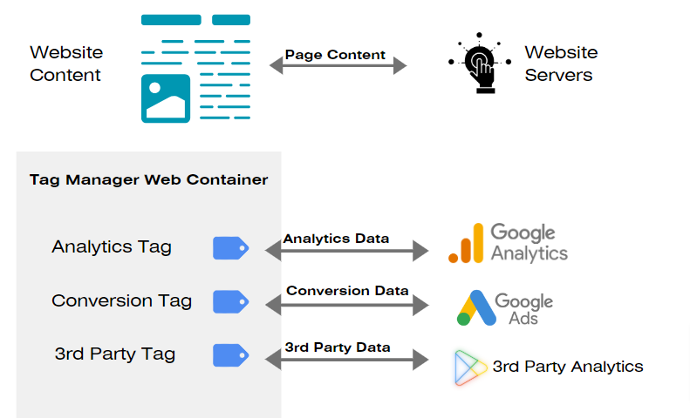Server side tagging in GTM - Harnessing Stape.io
In the fast-paced world of customized solutions and analytics, staying ahead of the curve is essential. Server-side tagging has emerged as a game-changer, offering a new approach to data collection and analytics. In this article, we'll delve into the realm of server-side tagging, explore its benefits, and introduce you to the remarkable capabilities of stape.io. Additionally, we'll show you how EWall Solutions can make your journey smoother by seamlessly integrating stape.io and Google Tag Manager (GTM) with our expert developers.
Understanding the server side tagging
Server-side tagging is a revolutionary method of sending tracking and measurement data from a website or app to third-party services directly from the server that hosts the site. Unlike traditional client-side tagging, which relies on scripts executed on the user's device, server-side tagging conducts data collection and processing on the server itself.
How does GTM work without server-side tagging?
When a webpage loads, it includes the Google Tag Manager (GTM) snippet, which, along with the rest of the webpage, is loaded into the user's browser. This snippet is responsible for triggering various tags based on your configuration, with one of them being the Google Analytics 4 tag. This entire process takes place on the client-side, within the user's browser.
During this client-side operation, JavaScript codes are activated, gather data, and then transmit this data to external destinations. For instance, the GA4 snippet sends the collected data to google-analytics.com.

Apart from the specific data you've directed Google Analytics to collect, such as tracking button clicks and URLs, these tracking codes often gather additional information about the webpage itself, the user's device, and other relevant details.
It's important to note that not all tracking codes are the same when it comes to privacy. Some are designed with a privacy-conscious approach, while others employ more aggressive techniques, including fingerprinting and utilizing first-party cookie information, which can raise concerns related to cross-site tracking and user privacy.
Reference Article: Server Side Intro
How GTM works with Server side tagging!
With the implementation of server-side tagging, an additional layer is introduced into the data collection process, which resides on your own server or servers hosting a server-side Google Tag Manager (GTM) container.

Within this server-side GTM container, Google Tag Manager receives data from client-side tracking codes, processes it, and, if necessary, applies manipulations before transmitting it to third-party vendors or potentially internal analytics tools that you utilize.
As a result, a combination of client-side and server-side components comes into play. In certain scenarios, it may not be necessary to incorporate client-side tracking for specific tasks. Instead, you can efficiently gather data from your server to your GTM server-side setup and then relay it to designated marketing or analytics endpoints.
Benefits of Server-Side Tagging
1. Enhanced Privacy: Server-side tagging minimizes data collection on the user's device, bolstering user privacy and compliance with data protection regulations.
2. Improved Performance: By reducing the load on the user's device, server-side tagging leads to faster page load times and a smoother user experience.
3. Greater Control: Website owners have more control over the data they collect and can apply custom logic and enrichment before sending it to third-party services.
4. Reduced Data Loss: Server-side tagging mitigates data loss due to ad blockers and tracking prevention mechanisms, ensuring more accurate analytics.
Related Article: Manual Setup Guide
Features of Server-Side Tagging
Server-side tagging offers an array of features, including:
- Custom Data Processing: Server-side scripts can manipulate and enrich data before forwarding it to third-party platforms.
- Flexibility: It supports a wide range of use cases, from e-commerce tracking to advertising analytics.
- Data Security: Server-side tagging minimizes the risk of data breaches, enhancing data security.
Unlocking the Potential with stape.io
Stape.io is a powerful tool that takes server-side tagging to the next level. It offers:
- Easy Integration: Stape.io simplifies the integration of server-side tagging into your website or app, reducing development time and effort.
- Comprehensive Analytics: It provides detailed insights into user behavior, enabling data-driven decision-making.
- Real-time Tracking: Stape.io offers real-time tracking capabilities, ensuring you're always up-to-date with your analytics.
- Customizable Workflows: Tailor server-side tagging workflows to your specific requirements, allowing for greater flexibility.
Related Article: Benefits of Stape hosting for the Google Tag Manager Server
EWall Solutions: Your Integration Partner
At EWall Solutions, we understand the complexities of server-side tagging and how to make it work seamlessly for your business. Our experienced developers can integrate stape.io and Google Tag Manager (GTM) into your website or app, and you can move Facebook, Universal analytics, GA4, Snapchat, Bing, Reddit, Pinterest, Yandex, Klaviyo (and some other email platforms) to a server-side tagging (LinkedIn and Twitter do not support server-side tagging yet) ensuring that you harness the full power of server-side tagging without the headaches of implementation. Reach us today!
The Bottom Line
In conclusion, server-side tagging is a transformative approach to data collection and analytics, offering enhanced privacy, performance, and control. When combined with the capabilities of stape.io and the expertise of EWall Solutions, you can unlock the full potential of server-side tagging for your business.
Considering that it eliminates all current and potential client-side tracking limitations, server-side tagging serves as a viable replacement for client-side tagging. However, because the technology is still in its earliest stages, server-side tracking cannot fully replace client-side tracking. Server-side tagging, however, appears to be emerging as a new standard for online analytics. Contact us today, and let's embark on a data-driven journey towards success.